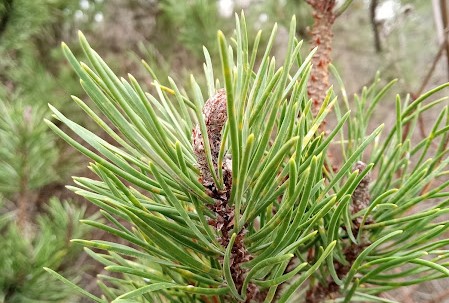This post is part of an ongoing series where I’ll periodically highlight a particular plant, animal, or other living thing, with an emphasis on its unique adaptations and prospects for its survival. Usually, these will be species with whom I have personal experience.
The lodgepole pine (Pinus contorta) is almost unique among Northwest conifers in that it is habitually found in two seemingly very different habitats: the dry, fire-prone forests east of the Cascades Range, and right along the coast. There has been some debate over the years about how much the differences in appearance between inland and coastal populations of lodgepoles are due to genetics, and how much is simply a result of the trees growing in two contrasting environments–and it is common to refer to use the name “shore pines” for the coastal trees. However, the latest verdict from this recent Oregon State University post is that they are simply varieties of the same species.
Lodgepole pines are trees of the Western United States and Canada, and in particular the Northwest. They are common in the Cascades and the Northern Rockies, as well as in the drier lowlands between these two mountain ranges–but farther south, they are replaced by other, related species like pinyon pine. Lodgepoles are relatively small, fast-growing trees adapted to life in an environment where periodic wildfires are normal. In fact, they produce serotinous cones–pinecones whose scales are sealed shut by resin and unfurl to release their seeds only in the presence of intense heat created by fire. Naturalists sometimes talk about lodgepoles as if all cones on the species were serotinous and relied on fire disperse their seeds, which might lead you to wonder how the trees on the wet coast ever manage to reproduce. The answer is that lodgepoles actually grow both serotinous and non-serotinous cones, depending on the age and genetics of the individual tree. You can read more about serotiny here.
Lodgepoles are the only native true pine you’re likely to find growing at sea level west of the Cascades. However, other parts of their range overlap with the ranges of different pine species, such as Ponderosa and western white pine. The surest way to tell for certain that you are looking at a lodgepole is to examine the needles, which are of medium length and grow in bundles of two. No other pine in the lodgepole’s native habitat matches that description; Ponderosa’s have three needles per bundle, while western white pine has five. In addition, lodgepoles are a smaller, more scraggly tree than most other pines–particularly compared to stately Ponderosas, which grow to massive size by comparison. Add to this the fact that lodgepoles generally have greyish bark, while Ponderosa bark has a reddish hue, and you’re unlikely to confuse these two species.
Places that come to mind when I think of lodgepole pine include the dryish forests of western Montana, the eastern slopes of the North Cascades, and wind-battered cliffs along the Washington and Oregon coasts. Historically, this tree’s range has been restricted to these types of environments, and once you go slightly inland from the coast, travelling east, you are unlikely to find many lodgepoles again until you cross the divide of the Cascades. However, with the climate of the Pacific Northwest becoming progressively warmer and drier, it’s entirely possible that we’ll see these adaptable, fire-loving trees broaden their range in years to come.



Leave a comment